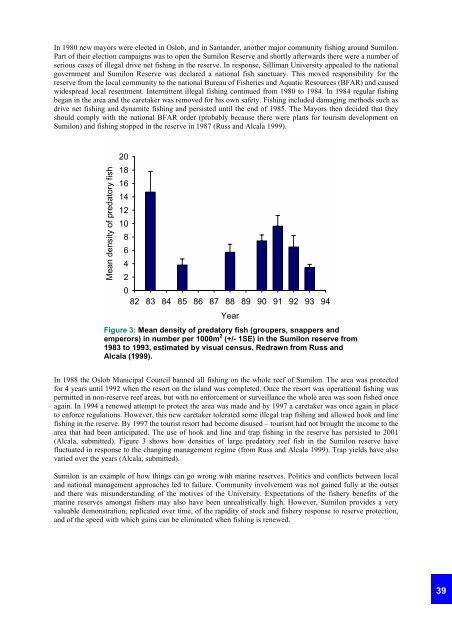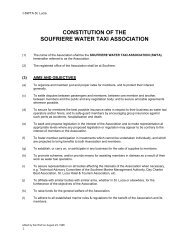Russ and Alcala (1996) assessed changes in predatory fish density between 1983 and 1993. Inside the reservethere was a steady increase in density, particularly of snappers and emperors (Figure 2). An update on fishdensities is forthcoming, and the trend of increase apparently is continuing (G.R. Russ pers. comm.).Despite setting aside 10% of the reefs where they previously fished, fishers in Apo appear to be benefiting fromthe no-take area, with line fishing CPUE increasing by an order of magnitude. There have been other benefitstoo. Two tourist resorts were developed on Apo in the 1990s and many visitors are attracted by the marinereserve. Apo has other dive sites, but the reserve is internationally known and is where the tourists want to dive(Bernando 2001). Alcala (1998) estimated that through reef-associated tourism, the local economy wasbenefiting by US$500 per hectare of reef per year (taking into account all the reef area of Apo, not just thereserve).Bernando (2001) gives further insight into the effects of the reserve in his study of environmental impacts anddistribution of benefits. He assessed socio-economic indicators such as household income, fishing income, skillsdevelopment, reserve income, environmental awareness, management capacity and capability to enhance orgenerate local policies. All had improved since 1984. He estimated benefits from the reserve to be in the regionof US$200,000 in 2000, but noted that much was going to dive shops and resorts rather than directly to thecommunity. However, the local community benefit from tourism not only by being employed in the resorts, butalso through independent enterprises such as the sale of t-shirts and other souvenirs. His interviews showed thatfishers perceived their catches increasing in response to protection up until 1992, then declining, particularly inthe past five years (1995-2000) whereas Maypa et al. (2002) show that CPUE continued to increase until 1997/8but had decreased in 2000/1. Perceived decreases in catch corresponded to the establishment in 1991 of the firsttourist resort on the west of the island (a second resort was built near the main village in 1996). The presentmanagement authority of the reserve, the Apo Island Protected Landscape/Seascape (APLS) Protected Area<strong>Management</strong> Board, collects visitor entrance fees and levies fees for diving, snorkeling, and mooring andanchoring in the area. From the income generated from fees 75% goes back to the community for themanagement of the reserve and for community projects, whilst 25% goes to the Protected Area <strong>Management</strong>Board and the Department of Environment and Natural Resources.Important factors in the success of Apo include training opportunities for fishers, women and young people ofthe Apo community and the reliable and continued technical support of the Silliman University since the reservewas established (pers. obs. A. Maypa). The establishment and maintenance of a marine education andcommunity centre has also provided a focus for the management and maintained enthusiasm in the area, andprovided an “immediate and tangible benefit” for community involvement (Russ and Alcala 1999).In Russ and Alcala’s (1999) assessment of the management success of Apo, they conclude that all of the statedobjectives for the area have been fulfilled. Fishing is almost entirely confined to local people, destructive fishingtechniques are not used, there has been a build up in fish biomass and there is strong evidence for the export ofadult fish to adjacent fished areas, and a successful local tourism industry has developed.SumilonThe early history of the Sumilon Reserve, also in the Central Philippines, about 44km away from Apo, is similarto that of Apo. However, important differences are that Apo has a resident community whereas Sumilon isuninhabited and is fished by people from several communities. In 1973 biologists and social scientists fromSilliman University began a marine conservation and education programme with the southern Cebu communitieswho fished Sumilon. The idea for a marine reserve evolved out of this programme. Scientists chose Sumilonbecause it had relatively good coral cover and fish, and one of the objectives of the reserve was to increase fishyields. In 1974 the Sumilon Reserve was formally established through a local government ordinance, with anagreement between Silliman University and Oslob Municipal Council (that has jurisdiction over Sumilon). Theagreement gave Silliman University authority “to establish a marine park around the island for marine biologicalstudies and research”, and a no-take area was established. Its objectives were very similar to those at Apo,including protection of fish habitat, fish biomass build-up in the reserve and export of fish and their offspring toenhance catches. It was also designed to encourage tourism in the area.The reserve was enforced by a caretaker who was a local fisher, and he also monitored fish yields in adjacentareas. A study of fishers’ perceptions in 1976 by social scientists from Silliman University revealed that manydid not really understand the purpose of the reserve (Cadeliña 1976). Despite this, in the late 1970s and early1980s many fishers reported increased catches (Alcala 1981, 1988, White 1988).38
In 1980 new mayors were elected in Oslob, and in Santander, another major community fishing around Sumilon.Part of their election campaigns was to open the Sumilon Reserve and shortly afterwards there were a number ofserious cases of illegal drive net fishing in the reserve. In response, Silliman University appealed to the nationalgovernment and Sumilon Reserve was declared a national fish sanctuary. This moved responsibility for thereserve from the local community to the national Bureau of Fisheries and Aquatic Resources (BFAR) and causedwidespread local resentment. Intermittent illegal fishing continued from 1980 to 1984. In 1984 regular fishingbegan in the area and the caretaker was removed for his own safety. Fishing included damaging methods such asdrive net fishing and dynamite fishing and persisted until the end of 1985. The Mayors then decided that theyshould comply with the national BFAR order (probably because there were plans for tourism development onSumilon) and fishing stopped in the reserve in 1987 (Russ and Alcala 1999).Mean density of predatory fish2018161412108642082 83 84 85 86 87 88 89 90 91 92 93 94YearFigure 3: Mean density of predatory fish (groupers, snappers andemperors) in number per 1000m 2 (+/- 1SE) in the Sumilon reserve from1983 to 1993, estimated by visual census. Redrawn from Russ andAlcala (1999).In 1988 the Oslob Municipal Council banned all fishing on the whole reef of Sumilon. The area was protectedfor 4 years until 1992 when the resort on the island was completed. Once the resort was operational fishing waspermitted in non-reserve reef areas, but with no enforcement or surveillance the whole area was soon fished onceagain. In 1994 a renewed attempt to protect the area was made and by 1997 a caretaker was once again in placeto enforce regulations. However, this new caretaker tolerated some illegal trap fishing and allowed hook and linefishing in the reserve. By 1997 the tourist resort had become disused – tourism had not brought the income to thearea that had been anticipated. The use of hook and line and trap fishing in the reserve has persisted to 2001(Alcala, submitted). Figure 3 shows how densities of large predatory reef fish in the Sumilon reserve havefluctuated in response to the changing management regime (from Russ and Alcala 1999). Trap yields have alsovaried over the years (Alcala, submitted).Sumilon is an example of how things can go wrong with marine reserves. Politics and conflicts between localand national management approaches led to failure. Community involvement was not gained fully at the outsetand there was misunderstanding of the motives of the University. Expectations of the fishery benefits of themarine reserves amongst fishers may also have been unrealistically high. However, Sumilon provides a veryvaluable demonstration, replicated over time, of the rapidity of stock and fishery response to reserve protection,and of the speed with which gains can be eliminated when fishing is renewed.39
- Page 1 and 2: The fishery effects ofmarine reserv
- Page 3 and 4: ContentsPart 1: Review1. Summary 62
- Page 5 and 6: Part 1: Review5
- Page 7 and 8: egan being published. Those studies
- Page 9 and 10: unprotected area (21.2cm vs 38.1cm)
- Page 11 and 12: species of snappers and grouper are
- Page 13 and 14: 6.1 What are the mechanisms involve
- Page 15: They concluded that reserves coveri
- Page 18 and 19: which there are decadal shifts in e
- Page 20 and 21: managed with reserves alone, while
- Page 22 and 23: However, in some areas fishers have
- Page 24 and 25: Literature citedAlder, J. (1996) Co
- Page 26 and 27: Fiske, S.J. (1992) Sociocultural as
- Page 28 and 29: Levine, A. (2002) Global partnershi
- Page 30 and 31: Roberts, C.M. and Hawkins, J.P. (20
- Page 32 and 33: Part 2: Case Studies32
- Page 34 and 35: Mean abundance of fish per count100
- Page 36 and 37: 2. Contrasting experiences from the
- Page 40 and 41: Key points• Very high reef fisher
- Page 42 and 43: 3. The effects of New Zealand marin
- Page 44 and 45: important species for recreational
- Page 46 and 47: Ballantine, W.J. (1991) Marine rese
- Page 48 and 49: experimental data obtained in the T
- Page 50 and 51: ReferencesAttwood, C.G. and Bennett
- Page 52 and 53: 5. Lobster fisheries management in
- Page 54 and 55: Rowe, S. and Feltham, G. (2000) Eas
- Page 56 and 57: fishers. At a meeting of fishers an
- Page 58 and 59: 7. Marine parks and other protected
- Page 60 and 61: 8. Community-based closed areas in
- Page 62 and 63: People are also seeing some species
- Page 64 and 65: 9. The Sambos Ecological Reserve, F
- Page 66 and 67: 10. The Nosy Atafana Marine Park, n
- Page 68 and 69: 11. Mombasa and Kisite Marine Parks
- Page 70 and 71: species that are mobile enough to d
- Page 72 and 73: Emerton and Tessema (2001) looked a
- Page 74 and 75: McClanahan, T.R. and Mangi, S. (200
- Page 76 and 77: Goodridge et al. (1997) collected b
- Page 78 and 79: offshore fishing with tourism, such
- Page 80 and 81: • The SMMA would have been improv
- Page 82 and 83: species decreased in the second fou
- Page 84 and 85: eserve in the form of increased cat
- Page 86 and 87: 15. Merritt Island National Wildlif
- Page 88 and 89:
Thousand Islands, St Lucie canal an
- Page 90:
is closed to scallop fishing. Ten y



